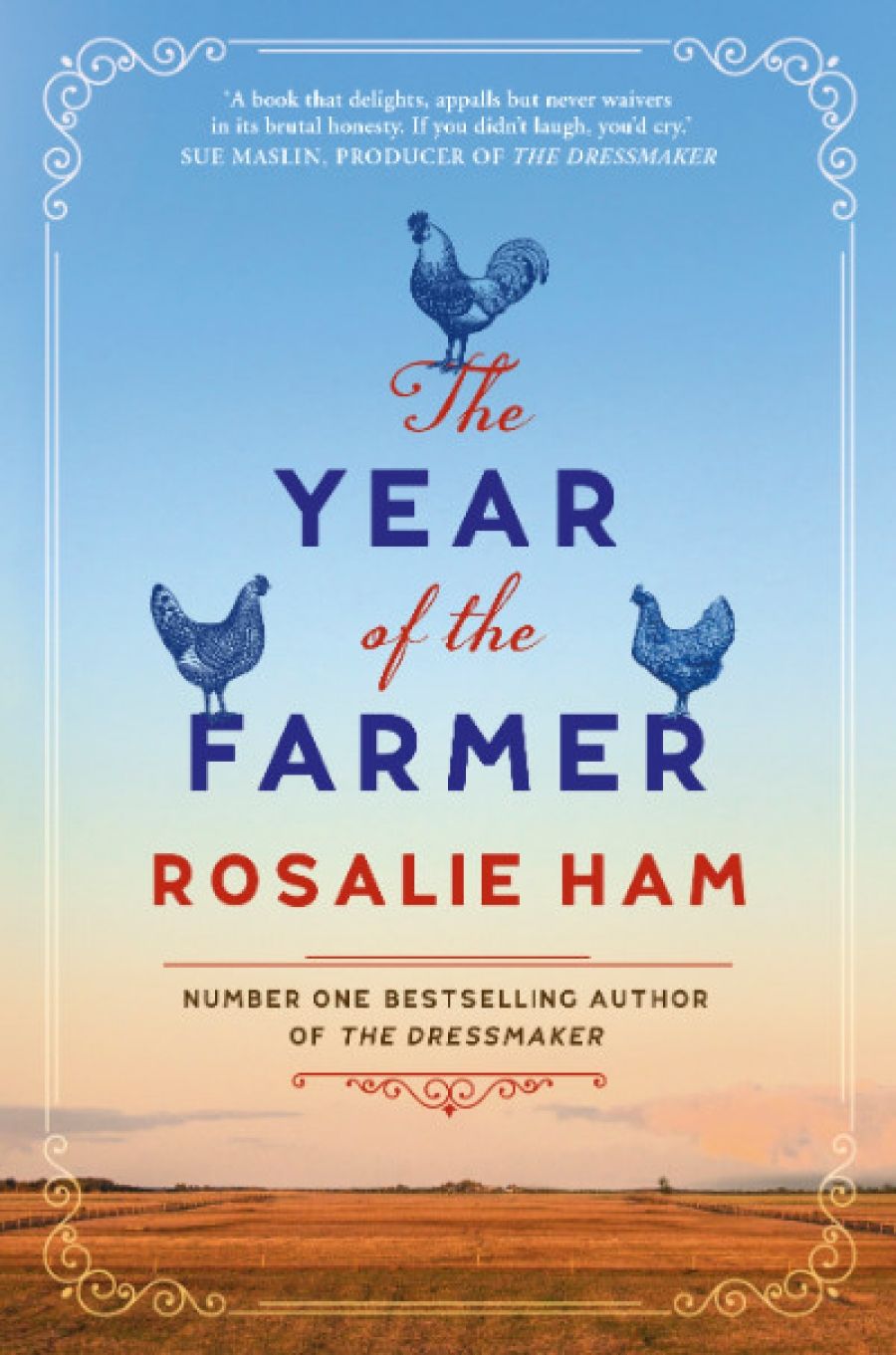
- Free Article: No
- Contents Category: Fiction
- Custom Article Title: Brenda Walker reviews 'The Year of the Farmer' by Rosalie Ham
- Review Article: Yes
- Online Only: No
- Custom Highlight Text:
‘In time and with water, everything changes,’ according to Leonardo da Vinci, who worked with Machiavelli on a strategic and ultimately doomed attempt to channel the flow of the Arno. Large-scale water management has had some notable successes in parts of Australia ...
- Book 1 Title: The Year of the Farmer
- Book 1 Biblio: Pan Macmillan, $32.99 pb, 336 pp, 9781760558901
Rosalie Ham’s fourth novel, The Year of the Farmer, uses a rural romance to put the case for the primacy of farmers and irrigators in a dysfunctional water buy-back scheme. As she suggests, there is a lot more at stake than the fate of individual farmers – food security depends on sound water management. One of her characters has a ‘vision’ of famine. He argues that he is expected ‘to work for nothing to feed everyone’. His is not the only appalled voice in the debate about the future of water in Australia. This debate is not usually conducted through popular romance, but the rural novel is Ham’s literary forte – she is best known as the author of The Dressmaker (2000).
The Year of the Farmer is set in a drought-stricken part of the Riverina where ‘paddocks [were] faintly ticking, crackling as they baked in the sun’, and ‘the air was perishingly dry’. Dogs run in packs across the country, threatening the sheep. Locals look out for their own, gossip, watch Australian Story on the ABC, and worry. The farmer in question is Mitch, popular, capable, and in difficulty. The girl he loves has left for the city, his compromised marriage is on the rocks, the drought has destroyed ten years of his efforts on the land, and he is increasingly entangled in a buy-back scheme run by self-interested, transitory, or venal bureaucrats. Everything depends on water, and farmers who have regarded the river as their own for generations must compete with tourism and development and listen to arguments from environmentalists who are completely alien to them.
Rosalie Ham has a fine eye for small-town politics and farm work. Her descriptions of the landscape are the greatest achievement of this novel. They seem to have the authority of long observation. Her genuine concern for the human cost of water allocation is the motivating force of the novel, although other issues such as the impact of divorce on farming families and the poignancy of the elderly, unable to continue on the land they love, also form part of her concerns. Consistent with the romance genre, change comes to the community and to Mitch. There is the possibility at least of happiness and restitution, and one of the mysteries of the plot is somewhat ambiguously solved. However the problems of drought and water management that the novel raises are not easily assuaged. There is far more to the issue than the considerable plight of farmers.
 Rosalie Ham
Rosalie Ham
In particular, irreconcilable conflicts arise from ideas about who owns river systems. Cathcart describes how Alfred Deakin legislated to ensure that rivers were in public hands, that is, that ‘no private individual could own a river or control the use of its water’. The relatively recent practice of water trading, a federal response to the degradation of rivers in Australia, reverses this. Irrigators may lease or sell water rights that are formally allocated to them in an attempt to restore the fatally – from an ecological point of view – diminishing flow of river water. This interference seems, to farmers, like a violation of long-held entitlement. In The Year of the Farmer, Mitch argues that ‘you’re taking my water and making me pay for it’. One farmer ‘thought about her river, the way it curved around the spot, and its busy population of fish, snakes, frogs, lizards and birds’. Relinquishment of what they believe to be exclusive ownership is hard, if not impossible, for these characters. In the book, an unpredicted release of water destroys a nineteenth-century system of barrages, resulting in immediate erosion. The barrages were built by the ‘ancestors’ of the farmers concerned, seeming to establish a venerable claim on the river and water management. However, there are more ancient and significant human interventions in rivers than nineteenth-century barrages. Cathcart describes the ‘Stonehenge’ of Australia, the extensive stone fish trap in the Darling river at Brewarrina. Aboriginal people are described as ‘gone’, or, more chillingly, ‘vanquished’ in the book, but they are the prior and, in this novel, silent river custodians with convincing claims to ancestral connections to the water. The Year of the Farmer also dismisses the legitimacy of non-farming interests. Environmental concerns about water management are raised in the novel: ‘If there’s no river there’s no water, there’s no nature, no farms, no food, no one to sell food, no town, no animals … nothing.’ But the voice for the environment is uttered by caricatures: a ‘ropey-haired scruff’, ‘ferals’, and ‘Centre-link avoiders’. Water authority bureaucrats are likewise discredited in the novel as ridiculous or corrupt. The novel cannot credit the complexity of water management or the legitimacy of more than one point of view.


Comments powered by CComment